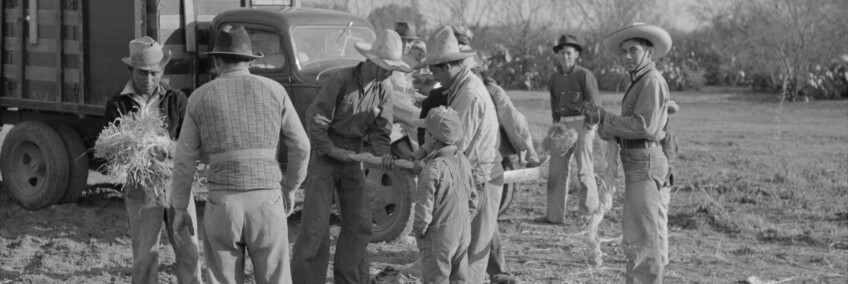How Migration Shaped Southern California's Gardens


Editor’s note: In “Lost L.A.: Descanso Gardens,” USC sociologist Pierrette Hondagneu-Sotelo comments on the largely unseen role of immigrant labor in creating Southern California’s gardens – a theme she explores in her book, “Paradise Transplanted: Migration and the Making of California Gardens” (University of California Press, 2014). Below, we share additional highlights from her interview for the episode with director Christopher Stoudt.
On gardens and nature. Gardens are not nature. They reflect humankind's aspirations to create beauty, transcendence, through plant nature. They're deliberately cultivated and maintained.
Gardens and labor. Gardens are sponges for labor and they're like sponges because sponges can hold a lot of water and we don't see it. It's invisible. Similarly, gardens look perfect to us and conceal all of the labor it takes to design them, plant them, maintain them.
On “grand gardens” like Descanso and the Huntington. I think it's important to locate the history of grand gardens in the history of California and the West more generally. If we think of our grand gardens, our most spectacular gardens in Southern California, certainly the Huntington Library and Botanical Gardens comes to mind, the Getty Villa, and we can think about Randolph Hearst's grand palace up the coast, as well. Now, all of these men were big-time industrialists and after accumulating their fortunes they needed a way to show their civilization, to display their status.
These industrialists, after accumulating their fortune, needed to show their civilized selves through arts, through display, and where did they look to? They were also basically … in the Wild West. They needed to tame this Wild West landscape. For Huntington that was transforming what had been productive avocado orchards into a grand garden. Where did they draw inspiration? They drew inspiration largely from Europe and Italy in particular.
Ornamental gardens as sites of privilege. Ornamental gardens are sites of privilege. Sometimes the doors are opened to others, as in the current era where children from poor, inner-city schools are bused to enjoy big gardens, but in general grand gardens are not widely accessible to poor people who live in inner-city neighborhoods. They're located far away. They're hard to find. The signage isn't clear. They're often expensive. There's an expensive entry fee. The garden clubs that have existed, I think, are just learning to open the doors a bit.
On Southern California’s original landscapers. I think if we want to go back and say who are the original landscapers of Southern California we need to look at Native Americans. I think often Native Americans are thought of as these were nomadic hunter-gatherers … but in fact there was a legacy of stewardship on the land.
On Japanese-American gardeners. Japanese immigrant and Japanese-American men really invented the occupation of residential landscape gardener as we know it today. Why? Japanese-Americans had a long tradition in agriculture. There's a very strong connection between the development of agriculture back home in California, and in the newly emerging cities and suburbs Japanese men who had worked on small family farms discovered they could go to homes of the well-to-do and tend their gardens for pay.
Why did Japanese men find such reception in this particular occupational niche? I think part of the reason has to do with Japan's promotion of itself as a nation of gardens. It was around the same time in history, around the turn of the last century, when Japan as a nation-state came to the big World's Fairs in Chicago, and San Diego, and San Francisco, and elsewhere, and showed beautiful displays of Japanese gardens, and bonsai, and flower arranging, thereby really whetting an Anglo-American appetite for the beauty of Japanese gardens and establishing a particular sensibility about Japanese gardens.


Gardening and “self-exploitation.” Residential maintenance gardening has been bound up with the whole immigrant labor system in Southern California. It's been a platform for both immigrant entrepreneurialism and the exploitation of immigrant labor. The Japanese largely left immigrant residential maintenance because they proved to be very upwardly mobile. Japanese-American gardeners went into the job and practiced self-exploitation so many of their sons and daughters wouldn't have to do those jobs.
The rise of Latino gardeners. As Japanese-American gardeners aged out of the system they hired Mexican immigrant laborers and sometimes gave or sold their gardening routes to Mexican immigrant gardeners who had had a similar entry into California through agricultural labor with strong traditions farm labor, both family farming and in agribusiness. Today maintenance gardening is largely a Latino immigrant man's job.
Gardens as migration projects. I think it's possible, as I've argued, that all gardens in Southern California are migration projects really. If you stop to think about it, most of the people in Los Angeles, most of the plants, and most of our water comes from elsewhere. We've put these together in different combinations in different periods of time and today we enjoy vestiges of these in special gardens. We can think of the San Gabriel Mission Garden. That's one particular form of garden that continues to inspire us but is rooted in a particular historical moment.



